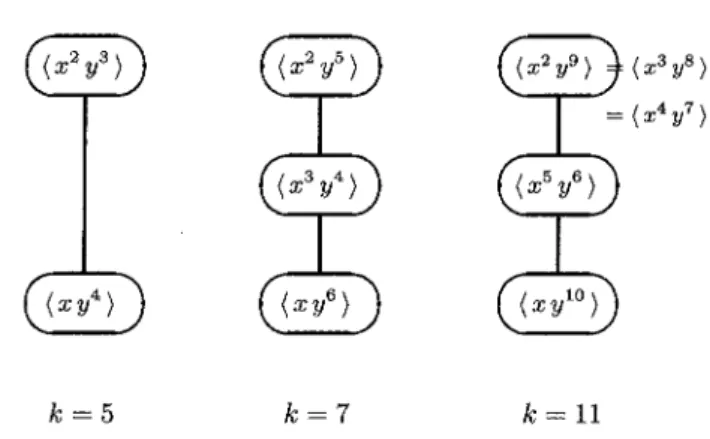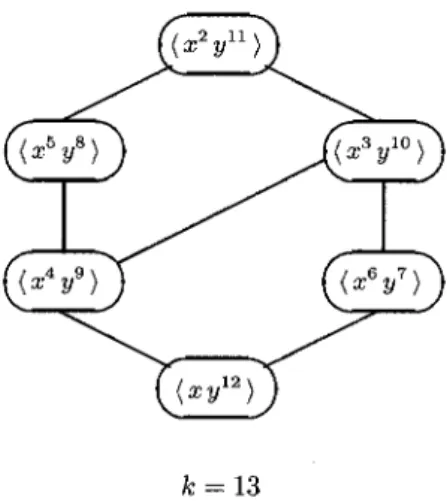A Note on Idempotent Monomial Clones : Two is Strong; One is Weak (Developments of Language, Logic, Algebraic system and Computer Science)
全文
(2) 65. For. the structure of. Property Hence,. For. a. denoted. defined. An. 2:. n ‐variable. a\in \mathrm{G} $\Gamma$(k). some. x\in \mathrm{G}\mathrm{F}(k). For every. 1:. and. subset S of. by (S}.. study of monomial as. r_{1}. \{f\}. =. .. ,. .. generated by. any. over. polynomial. a. ,. E_{k}. ,. ,. for n>0 , is. r_{n} with 0<r_{1}. is. a. \{S\}. .. ,. .. .. ,. function. n ‐variable. is the smallest clone. by \langle f\rangle. if C. is. motivated. partly. a. in. E_{k}. Let. .. a. monomial clone. Throughout. the. by. consider. we. f. defined. E_{k}. over. be. the rest of the paper,. generated by. generated by. Monomials stated. above,. the variable. a. a. over. E_{k}. .. some. monomial. produced. The. proof is. from monomials. If C. is minimal in the set. is said to be. s. we. consider 2‐variable. Hereafter, by. them.. f(a\ldots., a)=a ovcr \mathrm{G}\mathrm{F}(k) i_{j}\equiv 1 (\mathrm{m}\mathrm{o}\mathrm{d} k-1) (We. idempotent if f. satisfies. monomial with coefficient 1. idempotent. idempotent. monomials. monomial clone. a. .. .. monomial. Let. us. we. shall. denote. over. E_{k}. mean a. by \mathcal{M}_{k}. the. E_{k}.. x^{s}y^{t} we. consider 2‐variable monomials .. symbols.) Clearly,. when the exponents. and t. (For. convenience. s+t=k is. satisfy. an. x^{S}y^{t}. we use x. equivalent. for. 0 < s, t < k with the. and y instead of x_{1} and x_{2} , for ,. condition for. x^{8}y^{t}. to be. idempotent. 0<s, t<k.. is. a. monomial which generates. must be. a. 2‐variable monomial. m. of monomial. limited class of monomials and monomial clones. an n ‐varíablc. 2‐variable. over. additional condition s+t=k. (1). x_{n}^{r_{n}. Monomial Clones. set of such monomial clones. If. .. containing S and. following property.. m is idempotent if and only if \displaystyle \sum_{j=1}^{n} idempotent for polynomials in an obvious way.). monomial clone. m. .. (in \mathcal{L}_{k} ).. m=x_{1}^{i_{1}}\cdots x_{n}^{i_{n}}. and monomial clones. Note:. .. A monomial clone is. .. generated by. monomial cannot be. Evidently (by Property 1),. was. axí1. as. them.. abuse the term. As. expressed. r_{n}<k.. is denoted. monomial clone. which is not. minimal clone. Idempotent. 2.1. ex‐. finite field.. a. x^{k}=x.. \mathrm{G}\mathrm{F}(k). m over. .. the clone. clones is. In the rest of the paper. a. It is. .. uniquely. is. of composition.. clones then C is. for all. basic property of. ,. Lemma 1.1 Let C be. An. \mathrm{G}\mathrm{F}(k). is. a. \mathrm{G}\mathrm{F}(k). the Galois field over. introduce. us. C=\langle m\rangle.. ,. means. 2. as. defined. \mathcal{O}_{k} the clone generated by S. When S. E_{k} i. e.,. immediate. by. E_{k}. x_{n}\rangle. following. it holds that. monomial. integers. Definition 1.1 A clone C. The. ,. let. e,. follows.. as. m over. \mathrm{G}\mathrm{F}(k). \ldots. positive integer. a. treat. we. f(x_{1},. The. .. p and. have:. we. Property for. over. ,. function. n‐variable. polynomial. as a. prime. a. E_{k} that is,. finite ỉield into. a. well‐known that any. pressed. i.e., k=p^{e} for. power k ,. prime. a. x^{s}y^{t}. a. non‐unary minimal clone. and. (2). (in \mathcal{L}_{k} ) then, clearly,. the condition s+t=k must be. satisfied,.
(3) 66. k=5. k=7. Figure since. \langle x^{s}y^{t}\rangle. 1: Monomial clones for k=5 ,. composition. The proof Lemma 2.1 For with. is. integers. u,. (i). v. satisfying. J_{k} ) by composition,. Lemma 2.2 Let k be. Proof. 11. a. s+t=k'. ). on. the exponents is. preserved by. straightforward.. Some easy consequences. (1). 7,. does not contain any non‐trivial unary functions.. The next lemma shows that the condition. (together. k=11. are. prime. i. e.,. 0 < u,. v. <. x^{u}y^{v}\in\{x^{S}y^{t}\rangle. ,. k,. if x^{u}y^{v}. then. we. is obtained. have. from x^{s}y^{t}. u+v=k.. presented. power. For clones. \{xy^{k-1}\}\underline{\subseteq} \{x^{2}y^{k-2}\}. on. GF(k). we. have the. following.. (2) \{x^{4}y^{k-4}\rangle\subseteq\langle x^{3}y^{k-3}). From. (k-2)^{2} = ((k-1)-1)^{2} \equiv 1 (\mathrm{m}\mathrm{o}\mathrm{d} k-1) it follows that. x^{2}(x^{2}y^{k-2})^{k-2}=x^{k-1}y.. (ii) Similarly,. (k-3)^{2} = ((k-1)-2)^{2} \equiv 4 (\mathrm{m}\mathrm{o}\mathrm{d} k-1) implies. 3 In. x^{3}(x^{3}y^{k-3})^{k-3}=x^{k-4}y^{4}.. Two is Figures. and 13.. \square. strong; One is weak. 1 and 2 the set. An observation. refer the exponents of. \mathcal{M}_{k} of. we. one. the monomial clones is shown for the. cases. get from these diagrams is the following (where. variable):. Two is strong and. one. is weak!. k=5 , 7, 11 two and. one.
(4) 67. Figure. Two is. 3.1. Proposition. 2: Monomial clones for k=13. strong. 3.1 For any. power k>1 and any 0<s<k , it holds that. prime. \langle x^{S}y^{k-s}\rangle \underline{\subseteq} \{x^{2}y^{k-2}\rangle. In other. words,. \{x^{2}y^{k-2}\}. Proof We shall prove Basis:. is the. largest. clone in. x^{S}y^{k-\mathrm{s}}\in\{x^{2}y^{k-2}\rangle for i.e., xy^{k-1}. The monomial with s=1 ,. ,. \mathcal{M}_{k}.. any. 0<s<k. by induction. is obtained from. x^{2}y^{k-2}. on s.. in the. following. way.. y^{2}(y^{2}x^{k-2})^{k-2} = x^{(k-2)^{2}}y^{2k-2} = xy^{k-1} Thus. we. have. Inductive and. x^{S}y^{k-s}\in\langle x^{2}y^{k-2} ). Step:. x^{2}y^{k-2}. as. for s=1 , 2.. \displayst le\mathrm{L}\frac{k}2\rflo r. $\Gamma$ \mathrm{o}\mathrm{r} any 1 < t <. ,. we. obtain. x^{2t-1}y^{k-2\mathrm{s}+1}. and. x^{2t}y^{k-2s}. from. x^{t}y^{k-t}. shown below.. \left\{ begin{ar ay}{l} (x^{t}y^{k-t})^{2}x^{k-2}=x^{2t+k-2}y^{2k-2t}&=x^{2t-1}y^{k-2t+1}\ (x^{t}y^{k-t})^{2}y^{k-2}=x^{2t}y^{3k-2t-2}&=x^{2t}y^{k-2t} \end{ar ay}\right. This. completes. 3.2. the. proof.. \square. One is weak. Lemma 3.2. The clone. \{xy^{k-1}\rangle. Proof For any monomial. shows the. Now. a. minimality of. m. in. { xy^{k-1}\rangle\backslash J_{k}. \langle xy^{k-1}\rangle. question arises, which. is minimal in. in. we. ,. \mathrm{M}_{k}.. it is easy to. \mathrm{M}_{k}.. shall call. verify. that. xy^{k-1}. \in. \langle m }.. This \square. Question A..
(5) 68. Question that. \mathrm{A} :. \{xy^{k-1}\rangle. \langle xy^{k-1}\rangle. Is the clone. \subseteq. \langle x^{S}y^{k-s}\rangle. uniquely. minimal in. \mathcal{M}_{k} ?. That is to say, is it true. i.e.,. ,. xy^{k-1}\in\langle x^{s}y^{k-s}\rangle holds for any prime power k>1 and any 0<s<k ? Remark:. It may. \langle x^{s}y^{k-\mathrm{s} \rangle =\langle xy^{k-1}\rangle. that. happen. may also be said to be minimal in. 2\leq s<k is. 3.3. \mathcal{M}_{k} if. not minimal in. Partial results. \mathcal{M}_{k}. What. .. \{x^{S}y^{k-s}\rangle. we. for. some. s>1 in which ,. is distinct from. \{x^{s-}y^{k\mathrm{s} \} \{x^{s}y^{k-s}\rangle for. case. want to know is whether. \langle xy^{k-1}\rangle.. Concerning Question \mathrm{A}. Lemma 3.3 Let k=2h+1. .. xy^{k-1}. Then. \in. \{x^{h}y^{k-h}\rangle.. Proof We get. (x^{h}y^{h+1})^{h}(y^{h}x^{h+1})^{h+1} = x^{h^{2}+(h+1)^{2}}y^{2h(h+1)} = xy^{2h} = xy^{k-1} since 2h. k-1.. =. \square. Lemma 3.4 For k>2 and 1<a<k ,. (i). a^{e}\equiv. if. (\mathrm{m}\mathrm{o}\mathrm{d} k-1). 1. there exists e>1. (ii). or. a^{e}\equiv. satisfying. (\mathrm{m}\mathrm{o}\mathrm{d} k-1). a. then. xy^{k-1}\in\langle x^{a}y^{k-a}\rangle Proof. Since. However,. (ii). (i) By repeating. .. Here the. .. we. enjoy. a. .. x^{a}y^{k-a}. ((x^{a}y^{k-a})^{a}y^{k-a})^{a}. .. .. into. xe. proof we present. times,. )^{a}y^{k-a})^{a}y^{k-a}. we. the. (ii).. proof separately.. obtain:. =. x^{a^{e}}y^{*}. =. xy^{k-1}. have:. ((x^{a}y^{k-a})^{a}y^{k-a})^{a}. symbol. it suffices to show the result under the condition. kind of symmetry in the. substitution of. .. (ii) Similarly,. (i),. follows from. in order to. *. put. on. y. .. .. designates. (i) in coprime, i.e., \mathrm{G}\mathrm{C}\mathrm{D}(a, k-1)=1. Note that the condition. )^{a}y^{k-a})^{a}x^{k-a}. a. x^{a^{e}+(k-a)}y^{*} x^{a+(k-a)}y^{*} = x^{k}y^{k-1} = xy^{k-1} =. =. suitable exponent.. Lemma 3.4 is. equivalent. \square. to. saying that. a. and k- 1. are.
(6) 69. One is. 3.4 We. answer. Provably. Weak. Question A affirmatively.. Lemma 3.5 For any k>0 and. The next lemma. s\in E_{k} there. plays. exists n>0. s^{n} \equiv (s^{n})^{2} (\mathrm{m}\mathrm{o}\mathrm{d} k-1) Proof. This. Since k is finite, there exist i. obviously implies s^{i}. satisfies. cp\geq i (e.g.,. \lceil i/p\rceil ). c=. and let. key. rôle in the. .. any r>0. a=cp-i Then, .. proof.. satisfying. and p > 0 such that s^{\acute{l}. > 0. s^{i+rp} (\mathrm{m}\mathrm{o}\mathrm{d} k-1) for. \equiv. a. we. .. Take. s^{i+p}. \equiv. an. (\mathrm{m}\mathrm{o}\mathrm{d} k- 1). .. integer c>0 which. have:. s^{i+a} \equiv s^{i+cp+a} (\mathrm{m}\mathrm{o}\mathrm{d} k-1) \equiv s^{2i+2a} (\mathrm{m}\mathrm{o}\mathrm{d} k-1) \equiv (s^{i+a})^{2} (\mathrm{m}\mathrm{o}\mathrm{d} k-1) Let n=i+a. Proposition. Then. .. has the. n. 3.6 For any. required property.. prime. \square. power k>1 and all 0<s<k , it holds that. \langle xy^{k-1}\rangle\subseteq\{x^{s}y^{k-s}\}, that \dot{u},. \{xy^{k-1}\}. Proof We show. n>0 such that. Thus, a. is. uniquely. minimal in. \mathcal{M}_{k}.. xy^{k-1} \in\langle x^{8}y^{k-s}\rangle for any s^{n} \equiv (s^{n})^{2} (\mathrm{m}\mathrm{o}\mathrm{d} k-1) .. t satisfies. t^{2}. \equiv. t. (\mathrm{m}\mathrm{o}\mathrm{d} k-1). 0<s<k. .. Denote s^{n}. According by. to Lemma 3.5 there exists. t.. x^{t}y^{k-t}\in \{x^{s}y^{k-s}\} Now,. and. .. from. x^{t}y^{k-t}. construct. monomial. (x^{t}y^{k-t})^{t}x^{k-t}=x^{t^{2}-t+1}y^{t(k-t)}. Since t^{2}-t. \equiv. 0. (\mathrm{m}\mathrm{o}\mathrm{d} k-1). ,. we. have. x^{t^{2}-t+1}y^{t(k-t)}=xy^{k-1}, from which it follows that that. xy^{k-1} \in\{x^{t}y^{k-t}\rangle Together .. with. x^{t}y^{k-t}\in\langle x^{s}y^{k-s}\rangle. xy^{k-1}\in\langle x^{s}y^{k-s} }.. Note: Some of the contents. ,. we. conclude \square. presented. in this article. appeared. in. [MP17].. References [MP17] Machida,. H. and Pantovič, J., Three Classes of Closed Sets of Monomials, Proceed‐ ings 47th International Symposium on Multiple‐ Valued Logic, IEEE, 2017, 100‐105..
(7)
図


関連したドキュメント
Thus as a corollary, we get that if D is a finite dimensional division algebra over an algebraic number field K and G = SL 1,D , then the normal subgroup structure of G(K) is given
On the other hand, from physical arguments, it is expected that asymptotically in time the concentration approach certain values of the minimizers of the function f appearing in
In section 2 we present the model in its original form and establish an equivalent formulation using boundary integrals. This is then used to devise a semi-implicit algorithm
Kilbas; Conditions of the existence of a classical solution of a Cauchy type problem for the diffusion equation with the Riemann-Liouville partial derivative, Differential Equations,
In this paper, we generalize the concept of Ducci sequences to sequences of d-dimensional arrays, extend some of the basic results on Ducci sequences to this case, and point out
Let G be a split reductive algebraic group over L. In what follows we assume that our prime number p is odd, if the root system Φ has irreducible components of type B, C or F 4, and
In this paper, we consider the coupled difference system (1.1) for a general class of reaction functions ( f (1) , f (2) ), and our aim is to show the existence and uniqueness of
Condition (1.2) and especially the monotonicity property of K suggest that both the above steady-state problems are equivalent with respect to the existence and to the multiplicity